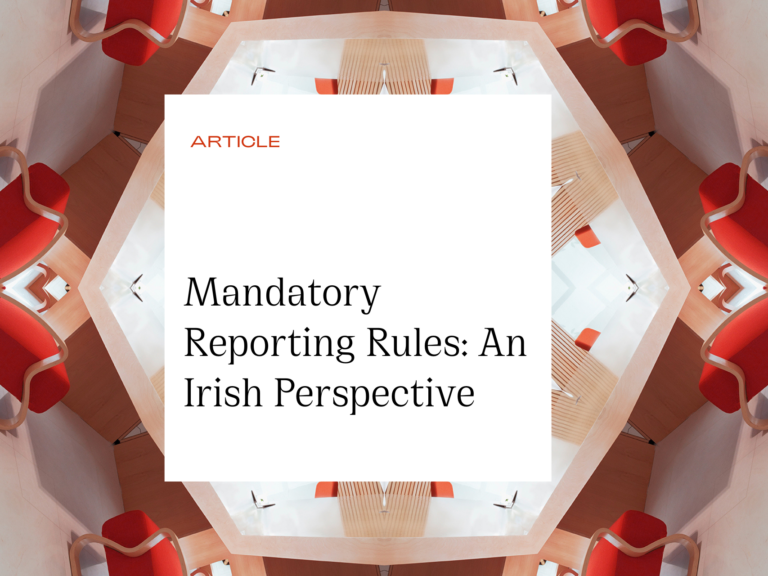
AT1 Capital Instruments: Corporation Tax
Finance Act 2019 extended the tax deduction for the return paid on AT1 capital instruments to comparable instruments issued by non-financial institutions. Revenue recently published the “Treatment of Additional Tier 1 Capital” which explains the requirements for equivalence.
Click here to view this briefing in PDF format.
Background
As a consequence of the 2008 financial crisis, prudential rules in the form of the EU Capital Requirements Directive IV package (the “CRD”) were introduced to require financial institutions to control risks and hold minimum capital levels. The CRD prescribes the features that an Additional Tier 1 (“AT1”) Capital instrument issued by a regulated financial institution and insurer must possess. Given the ability of these instruments to convert to equity to absorb losses and meet regulatory requirements, Irish tax legislation introduced in 2015 clarifies that, notwithstanding which of those features are utilised, an AT1 instrument would be regarded as debt and a coupon as interest for tax purposes. Similar provisions were introduced in other EU countries including the Netherlands.
Overview of changes
The European Commission expressed concerns that tax provisions ensuring tax deductions for coupon payments on AT1 capital instruments issued by regulated banks and insurance companies, may be discriminatory to non-regulated corporates. Despite there not having been a formal declaration by the European Commission or a decision of the CJEU that such provisions amount to state aid, certain EU jurisdictions, such as the Netherlands, have abolished the tax provision in order to avoid legal uncertainty for taxpayers which may result from state aid proceedings.
Rather than abolishing the favourable tax treatment of AT1 capital instruments, Ireland has addressed state aid concerns by extending the tax treatment to capital instruments that are substantially similar or equivalent to AT1 instruments even if not issued by financial institutions.
In such circumstances:
- the coupon payable on the AT1-equivalent instrument should be regarded as interest and may therefore qualify for tax deductibility and
- an interest withholding tax exemption should apply.
Revenue recently published guidance (the “AT1 Guidance”) (here) with further details on the requirements for equivalent treatment. Presumably, in making the change, Irish policy makers gained comfort from the knowledge that the anti-hybrid rules in Finance Act 2019 eliminate the possibility of tax avoidance through differential tax treatment between issuer and investor.
To determine whether the instrument is an AT1-equivalent instrument, the AT1 Guidance provides that the instrument should be compared against each of the criteria specified under Article 52 of the Capital Requirements Regulation (which forms part of the CRD). The AT1 Guidance provides that it would be expected that an ‘equivalent’ instrument would be one that shares the essential characteristics associated with AT1 instruments, not limited to the fact that:
- they possess the convertible capability associated with AT1 instruments, i.e. that the instruments can be written down or converted into equity upon a pre-specified trigger event;
- they are loss-absorbing;
- they are subordinated (where this occurs in a non-financial institutional context, the instrument is subordinated in a manner equivalent to that specified under Article 52);
- they are perpetual in nature with no incentive to redeem;
- the coupons are fully discretionary and non-cumulative;
- the distributions can be paid only out of distributable profits; and
- the purchase is not funded directly or indirectly by the issuer.
The characteristics at 1 and 2 are broadly similar from an economic perspective and, in our view, should be considered together. Subordination is achieved if the instrument ranks behind ordinary debt obligations of the issuer but ahead of the issuer’s common equity (ordinary shares).
Key takeaways
- The provision of a level playing field between financial institutions and other companies is welcome as it addresses residual state aid uncertainty for financial institutions.
- Whilst corporate bonds that deliver partial equity credit for rating purposes are currently rare in Ireland, they may become a feature of financing in Ireland in the current climate and it is always helpful to corporates to have the widest range of financing options.
- The AT1 Guidance states that it is prudent for non-financial institution taxpayers to either seek an opinion from the Revenue Commissioners that the instrument is equivalent prior to its issuance or include an expression of doubt with their tax return post-issuance. Revenue opinions on this new form of financing are very helpful.
For further information on this topic, please contact a member of the Arthur Cox tax team.



